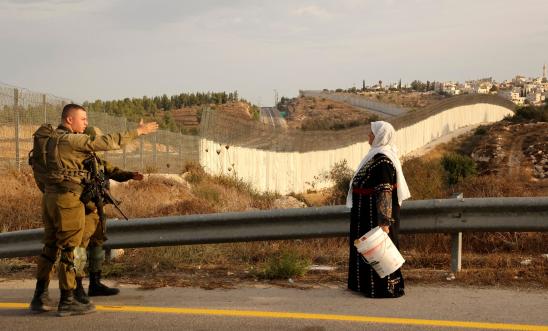
New Israeli PM - Same Old Apartheid and Annexation

This November will see the fifth Israeli elections in less than four years, with now ex-prime minister Naftali Bennett having handed over the reins to Yair Lapid, who will remain interim premier until a new government is sworn in after the next elections.
While the Israeli political paralysis seems never-ending, there is one constant that goes back much further - one advanced and backed by coalition governments of all varieties: Israel’s colonisation of the occupied West Bank.
Over the last 55 years, every Israeli government has pursued this project regardless of coalition make-up and with the active participation of every major state institution.
At the heart of such efforts are the settlements, of which there are now more than 200 – many ‘officially’ recognised by Israeli authorities, and many others ‘unofficial’ outposts which are, nevertheless, protected by the Israeli military and often serviced by utilities and infrastructure.
The settlement enterprise is a core part of Israel’s apartheid regime and, increasingly, is understood as such. This is understandable – settlements in the West Bank are a stark, visible form of land theft and displacement, a visceral form of discrimination and segregation.
At one level, you can look at the day-to-day reality – two population groups inhabiting the same territory but granted or denied different rights – and conclude, based on the evidence, that this is apartheid. Look at Hebron; some will say, or the Jordan Valley or Masafer Yatta.
This is true and important, but a further dimension is less often considered: namely, what the colonisation of the West Bank and the settlements tell us about Israeli intentions.
In Western political and policy-making contexts, Israel’s ‘presence’ in the West Bank, and even the settlements themselves, are still seen through – or at least shaped by – an Israeli discourse that has, strategically, emphasised ‘security needs’ and supposed non-permanence or reversibility.
To the extent that ideology is considered, it is usually restricted to a condemnation of settler ‘extremists’ – ultra-nationalist die-hards who lead efforts to settle new hilltops or take over buildings.
Thus, the settlements, Israeli government policies, and the structural legal ambiguity Israel has pursued in the West Bank is rarely seen for what it is – an unambiguous declaration of intent, a trajectory of incremental annexation, and an absolute rejection of Palestinian self-determination.
Let’s briefly consider just a few illustrations from two weeks in May.
On 12 May, Israeli occupation authorities approved plans for 4,427 housing units in settlements across the West Bank, including retroactive approval of settler outposts, doubling the size of the Dolev colony west of Ramallah, and a fivefold expansion of the Shvut Rachel colony south of Nablus.
The coalition was dubbed, by some, as a ‘government for change’ (out of naivety or self-interest). Yet when it comes to colonising the West Bank, the ‘change’ government meant absolute continuity, with more than 7,000 settlement housing units promoted from when it was sworn in to its collapse.
It is instructive that the three outposts submitted for retroactive approval under a coalition which included Meretz and the United Arab List were originally established during the premierships of Benjamin Netanyahu and Ariel Sharon. The leaders and parties change – colonisation advances.
And while Israeli authorities – government, military – advance settlements through the ‘proper channels’, many settlers, protected by occupation forces, take matters into their own hands. The day after those plans were approved, on 13 May, settlers invaded a Palestinian house in Hebron.
Meanwhile, for a reminder that the colonisation of the West Bank is not just about settlement houses and built-up areas, consider the decision published at the beginning of May by Israeli occupation authorities to declare the largest ‘nature reserve’ in the West Bank for 25 years.
Such designations mean even more restrictions for Palestinians than already exist in ‘Area C’ of the West Bank, including in relation to cultivation and grazing. ‘Nature reserves’ are another way the Israeli state takes over land and hems Palestinians into fragmented enclaves.
What is the significance of these three examples?
Together, they show how the colonisation of the West Bank has been a project enthusiastically pursued by the Israeli state and its institutions regardless of which parties make up any given coalition government. Politicians come and go; the dynamic structure of settler colonialism remains.
The fact that the Israeli state invests in settlements and colonial infrastructure all over the West Bank while restricting Palestinian access to and use of vast swathes of the same territory is not just a ‘practical’ obstacle to Palestinian statehood: it is a clear message, that Israel opposes Palestinian self-determination and sovereignty – and will continue to do so.
This is the conversation that is needed. It illustrates with far more clarity what is at stake and how it can be confronted than even well-intentioned talk of how a ‘two-state solution’ has become ‘impossible’ because of the ‘facts on the ground’ – as if by an unfortunate accident, the logistics have become just too difficult. Israel has intentionally established an apartheid system and intends to keep it that way – or worse – unless there is accountability.
Ben White is a writer and analyst, and the author of four books on Palestine.
Our blogs are written by Amnesty International staff, volunteers and other interested individuals, to encourage debate around human rights issues. They do not necessarily represent the views of Amnesty International.
0 comments